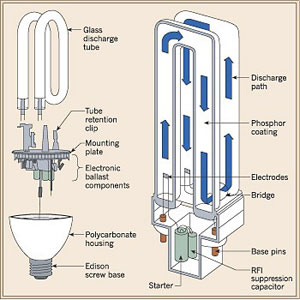What are they?
The compact fluorescent light bulb or lamp is a type of fluorescent lamp generally designed as a replacement for incandescent or halogen lamps. There are two major types of compact fluorescent lamp, screw-in and plug-in.
Screw in lamps are self-ballasted and can generally be placed in an existing screw socket without any additional equipment, plug-in bulbs require a ballast and a socket that corresponds to their specific base configuration. These are also sometimes referred to as integrated (screw base) and non-integrated (plug base).
Both come in a wide variety of wattages, sizes, color temperatures, and base types, and they are known primarily for their efficiency, long life, low cost, and ease of upgrading.
Where did they come from?

Although compact fluorescent lamps are considered to be a fairly recent technology,
this bulb type was actually over 100 years in the making. Circline and U-bent bulbs were both created to reduce the
overall length of fluorescent bulbs and were precursors to the CFL as it is known today.
The modern CFL was invented by Edward Hammer, an engineer at General Electric, but was not produced at the time due to high production costs. In 1980, Philips became the first manufacturer to mass-produce a compact fluorescent bulb with a screw-in base.
Over the last 30 years, the technology has continued to improve. Today’s CFL is smaller, produces more light per watt, warms up more quickly, has better light quality, and is much cheaper than those in years past.
How do they work?

Compact fluorescent lamps are functionally identical to linear fluorescent bulbs.
Both are gas-discharge lamps that use electricity emitted from cathodes to excite mercury vapor contained within the glass envelope, using a process known as inelastic scattering.
Phosphors and a noble gas such as argon are also contained within the glass envelope.
The mercury atoms produce ultraviolet (UV) light, which in turn causes the phosphors in the lamp to fluoresce or glow, producing visible light.
Where are they used?
Compact fluorescent lamps are continuously being improved and are ideal replacements in an ever-increasing number of applications, both commercial and residential. In particular, screw-in CFLs are ideal replacements due to the ease of upgrading. One can simply remove the old lamp and screw in the CFL. Plug-in CFLs require both a specific socket and a ballast, and therefore are more difficult to retrofit.
At this point, it is actually easier to discuss where CFLs are not ideal: They are not generally well-suited for use with control devices, such as dimmers, timers, or photo sensors (like motion detectors or daylight sensors). They may function in these applications, but rated life will likely be reduced and therefore this type of usage is not generally recommended or covered under manufacturer warranties. Some CFLs can be used with dimmers without affecting rated life, but only if they are specifically designed for that function and listed as dimmable lamps.
Other Helpful Resources